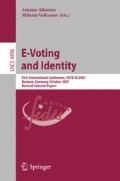Abstract
Some governments initially introduced postal voting as a way to facilitate overseas and absentee voter’s access to the electoral process. However, reliability issues that are part of postal voting have helped to introduce new remote voting channels based on electronic means. In the United States, electronic voting channels based on fax, email or Internet, are or have been used in binding elections. In this paper we identify which are the current remote voting channels used in the United Sates for overseas voters binding elections. We also identify which are the main criteria requirements used to evaluate the implementation of these remote voting channels, and provide a general comparison of the fulfilment of these requirements by these remote voting channels.
Access this chapter
Tax calculation will be finalised at checkout
Purchases are for personal use only
Preview
Unable to display preview. Download preview PDF.
References
Alvarez, R.M., Hall, T.E., Roberts, B.F.: Military Voting and the Law: Procedural and Technological Solutions to the Ballot Transit Problem. Institute of Public and International Affairs 16, 1–59
Republique Et Canton de Geneve. E-Voting. Available at: http://www.geneve.ch/evoting/english/welcome.asp
May 2007 Pilot Schemes. U.K (2007), Available at: http://www.electoralcommission.org.uk/elections/pilotsmay2007.cfm
Internet Voting in Estonia. Available at: http://www.vvk.ee/engindex.html#0003
The Parliament of the Commonwealth of Australia - Joint Standing Committee on Electoral Matters, The 2004 Federal Election - Report of the Inquiry into the Conduct of the 2004 Federal Election and Matters Related Thereto, September 2005, Canberra (Australia) (2005) (ISBN 0 642 78705 0)
United States Department of Defense (2007). Expanding the Use of Electronic Voting Technology for UOCAVA Citizens (May 2007)
Krimmer, R., Volkamer, M.: Bits or Paper? Comparing Remote Electronic Voting to Postal Voting. In: Wimmer, M.A., et al. (eds.) EGOV 2005. LNCS, vol. 3591, Springer, Heidelberg (2005)
Jefferson, D., Rubin, A., Simons, B., Wagner, D.: A Security Analysis of the Secure Electronic Registration and Voting Experiment (SERVE) (2004), Available at: http://servesecurityreport.org/paper.pdf
Voting over the Internet (VOI) Voting Project (2000). Available at: http://www.fvap.gov/services/voi.html
Qvortrup, M.: First past the Postman: Voting by Mail in Comparative Perspective. The Political Quarterly 76(3), 414–419 (2005)
Uhlmann, C.: Polls Apart. About the House. Australian House of Representative Magazine, (24) (August 2005)
Riera, A., Cervello, G. (2004). Electronic Voting in Europe. Technology, Law, Politics and Society, Workshop of the ESF TED Programme together with GI and OCG, July, 7th–9th, 2004, in SchloßHofen / Bregenz, Lake of Constance, 91–100 (2004)
VoteHere. Mail-in Ballot Tracker, http://www.votehere.com/ballottrackermailin.php
Federal Voting Assistance Program - U.S. Department of Defense, Appendix B Electronic Transmission of Election Materials. Voting Assistance Guide (2006), Available at: http://www.fvap.gov/pubs/vag/pdfvag/appendix-b.pdf
California Internet Voting Task Force (2000). Final report. Available at: http://www.ss.ca.gov/executive/ivote/
Riera, A., Brown, P., Ortega, J.A. (2003) Advanced Security to Enable Trustworthy Electronic Voting. 3rd European Conference on e-Government. Trinity College, Dublin, (June 2003)
Jefferson, D.: Requirements for electronic and internet voting systems in public elections. In: WOTE (2001)
Gerck, E. (2001). Internet Voting Requirements. The Bell 1(7), 3 (2000)
Neff, A., Adler, J.: Verifiable e-Voting Indisputable Electronic Elections at Polling Places. VoteHere Inc (2003)
Author information
Authors and Affiliations
Editor information
Rights and permissions
Copyright information
© 2007 Springer-Verlag Berlin Heidelberg
About this paper
Cite this paper
Puiggali, J., Morales-Rocha, V. (2007). Remote Voting Schemes: A Comparative Analysis. In: Alkassar, A., Volkamer, M. (eds) E-Voting and Identity. Vote-ID 2007. Lecture Notes in Computer Science, vol 4896. Springer, Berlin, Heidelberg. https://doi.org/10.1007/978-3-540-77493-8_2
Download citation
DOI: https://doi.org/10.1007/978-3-540-77493-8_2
Publisher Name: Springer, Berlin, Heidelberg
Print ISBN: 978-3-540-77492-1
Online ISBN: 978-3-540-77493-8
eBook Packages: Computer ScienceComputer Science (R0)

